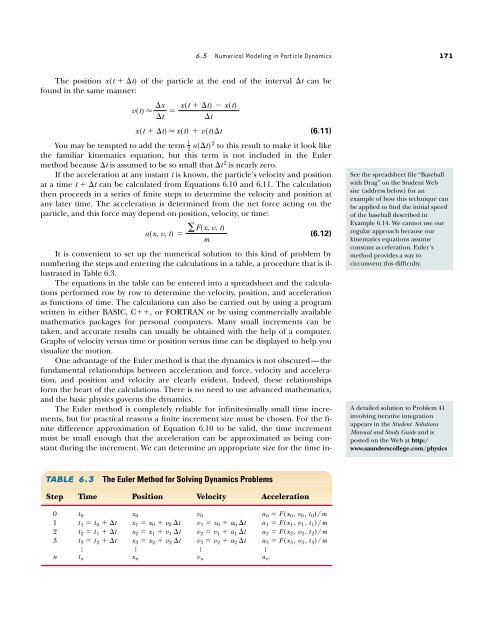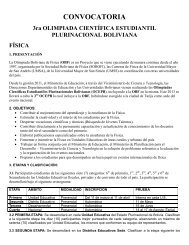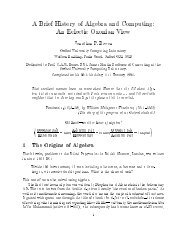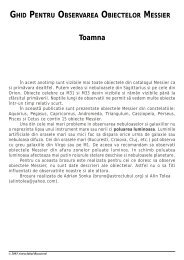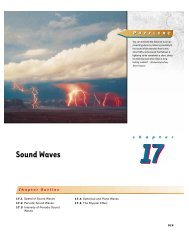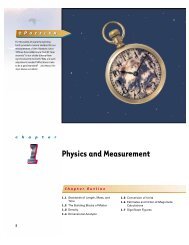Circular Motion and Other Applications of Newton's Laws
Circular Motion and Other Applications of Newton's Laws
Circular Motion and Other Applications of Newton's Laws
You also want an ePaper? Increase the reach of your titles
YUMPU automatically turns print PDFs into web optimized ePapers that Google loves.
6.5 Numerical Modeling in Particle Dynamics 171<br />
The position x(t ��t) <strong>of</strong> the particle at the end <strong>of</strong> the interval �t can be<br />
found in the same manner:<br />
(6.11)<br />
You may be tempted to add the term to this result to make it look like<br />
the familiar kinematics equation, but this term is not included in the Euler<br />
method because �t is assumed to be so small that �t 2 is nearly zero.<br />
If the acceleration at any instant t is known, the particle’s velocity <strong>and</strong> position<br />
at a time t ��t can be calculated from Equations 6.10 <strong>and</strong> 6.11. The calculation<br />
then proceeds in a series <strong>of</strong> finite steps to determine the velocity <strong>and</strong> position at<br />
any later time. The acceleration is determined from the net force acting on the<br />
particle, <strong>and</strong> this force may depend on position, velocity, or time:<br />
a(x, v, t) � (6.12)<br />
It is convenient to set up the numerical solution to this kind <strong>of</strong> problem by<br />
numbering the steps <strong>and</strong> entering the calculations in a table, a procedure that is illustrated<br />
in Table 6.3.<br />
The equations in the table can be entered into a spreadsheet <strong>and</strong> the calculations<br />
performed row by row to determine the velocity, position, <strong>and</strong> acceleration<br />
as functions <strong>of</strong> time. The calculations can also be carried out by using a program<br />
written in either BASIC, C��, or FORTRAN or by using commercially available<br />
mathematics packages for personal computers. Many small increments can be<br />
taken, <strong>and</strong> accurate results can usually be obtained with the help <strong>of</strong> a computer.<br />
Graphs <strong>of</strong> velocity versus time or position versus time can be displayed to help you<br />
visualize the motion.<br />
One advantage <strong>of</strong> the Euler method is that the dynamics is not obscured—the<br />
fundamental relationships between acceleration <strong>and</strong> force, velocity <strong>and</strong> acceleration,<br />
<strong>and</strong> position <strong>and</strong> velocity are clearly evident. Indeed, these relationships<br />
form the heart <strong>of</strong> the calculations. There is no need to use advanced mathematics,<br />
<strong>and</strong> the basic physics governs the dynamics.<br />
The Euler method is completely reliable for infinitesimally small time increments,<br />
but for practical reasons a finite increment size must be chosen. For the finite<br />
difference approximation <strong>of</strong> Equation 6.10 to be valid, the time increment<br />
must be small enough that the acceleration can be approximated as being constant<br />
during the increment. We can determine an appropriate size for the time in-<br />
�F(x,<br />
1<br />
2<br />
v, t)<br />
m<br />
a(�t)2<br />
�x x(t ��t) � x(t)<br />
v(t) � �<br />
�t �t<br />
x(t ��t) � x(t) � v(t)�t<br />
TABLE 6.3 The Euler Method for Solving Dynamics Problems<br />
Step Time Position Velocity Acceleration<br />
0 t 0 x0 v0 a 0 � F(x 0, v0, t 0)/m<br />
1 t 1 � t 0 ��t x1�x0�v0�t v1�v0�a0�t a1�F(x1, v1, t 1)/m<br />
2 t 2 � t 1 ��t x2�x1�v1�t v2�v1�a1�t a2�F(x2, v2, t 2)/m<br />
3 t 3 � t 2 ��t x3�x2�v2�t v3�v2�a2�t a3�F(x3, v3, t 3)/m<br />
n<br />
�<br />
tn �<br />
xn �<br />
vn �<br />
an See the spreadsheet file “Baseball<br />
with Drag” on the Student Web<br />
site (address below) for an<br />
example <strong>of</strong> how this technique can<br />
be applied to find the initial speed<br />
<strong>of</strong> the baseball described in<br />
Example 6.14. We cannot use our<br />
regular approach because our<br />
kinematics equations assume<br />
constant acceleration. Euler’s<br />
method provides a way to<br />
circumvent this difficulty.<br />
A detailed solution to Problem 41<br />
involving iterative integration<br />
appears in the Student Solutions<br />
Manual <strong>and</strong> Study Guide <strong>and</strong> is<br />
posted on the Web at http:/<br />
www.saunderscollege.com/physics


